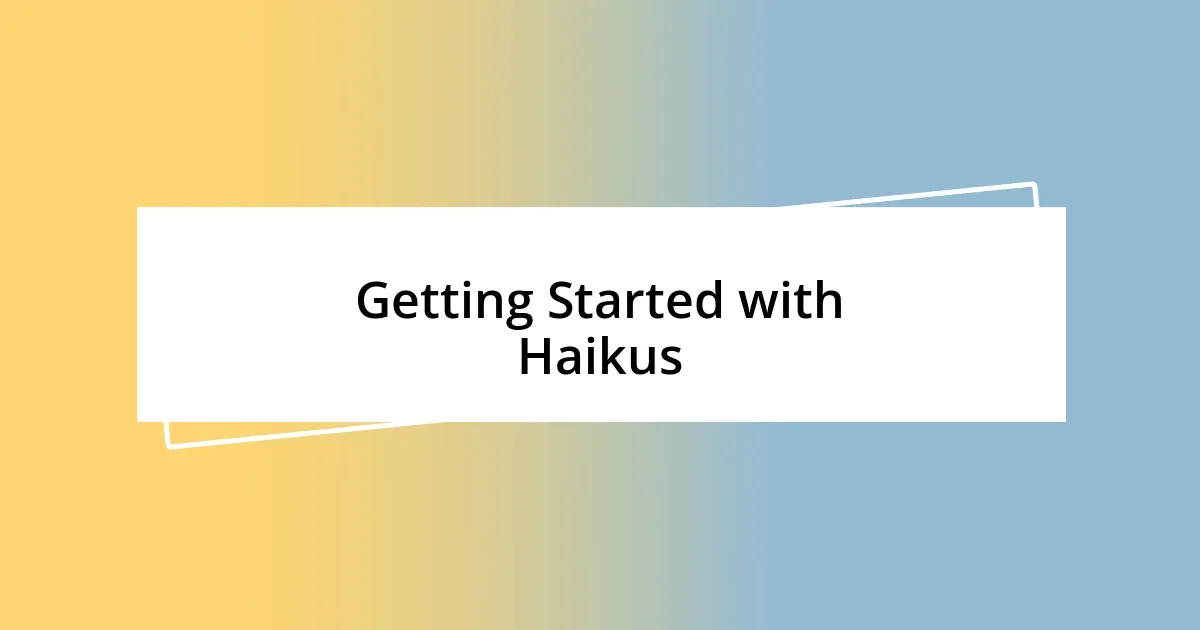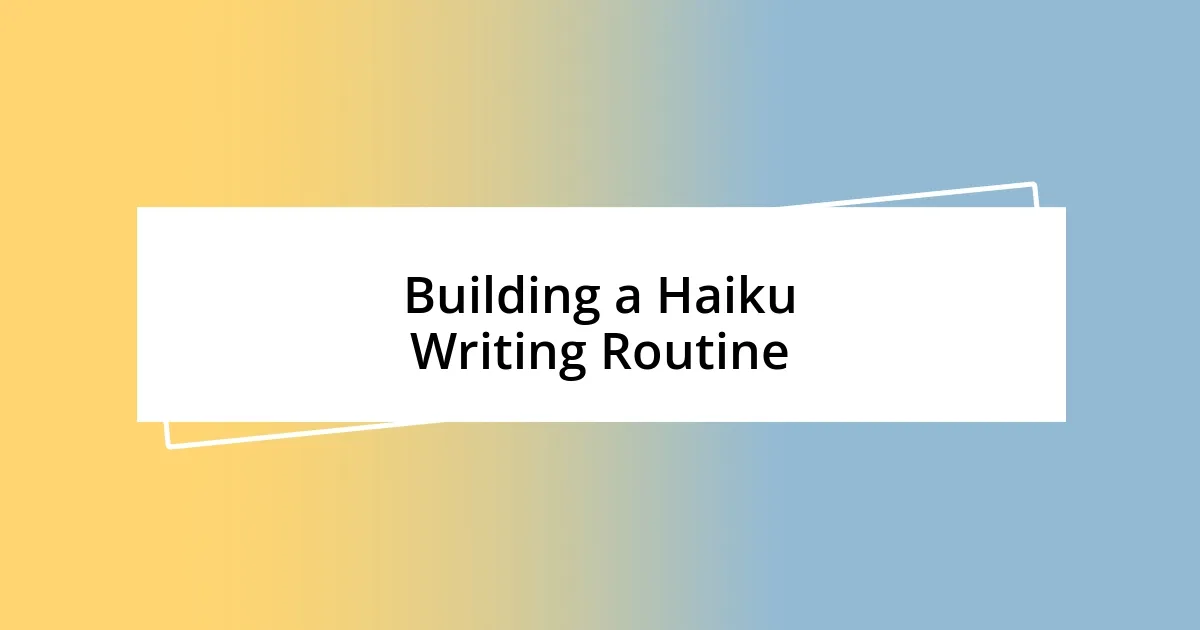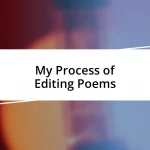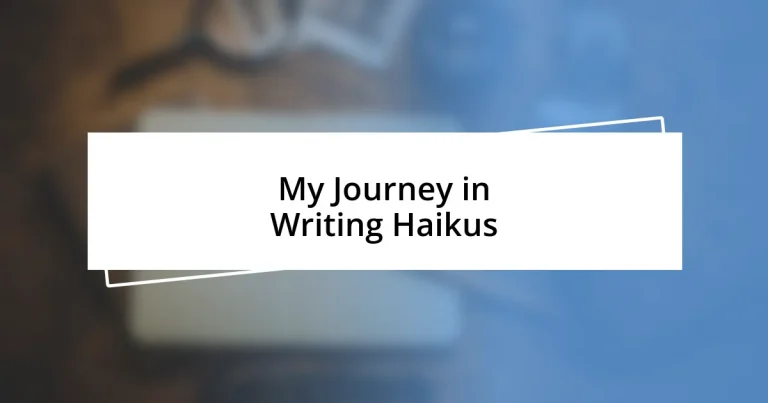Key takeaways:
- Haikus consist of three lines following a 5-7-5 syllable pattern, focusing on nature and capturing fleeting moments.
- Inspiration for haikus often arises from everyday life, nature, and personal experiences, highlighting the beauty in simplicity.
- Revising and editing haikus is crucial for enhancing imagery and refining expression, often aided by feedback from others.
- Building a writing routine, keeping a notebook handy, and embracing flexibility help nurture creativity in haiku writing.

Getting Started with Haikus
Starting to write haikus can feel both exciting and a bit daunting. I remember my first attempt; I was sitting in my backyard, inspired by the rustling leaves and the soft sound of a distant stream. What struck me then was how just a few words could capture such vivid imagery and emotion. Isn’t it fascinating how a form so simple can hold so much depth?
The traditional haiku consists of three lines with a 5-7-5 syllable pattern. I found that this structure helped me focus my thoughts and distill my experiences into concise moments. Have you ever paused to observe a single raindrop on a petal? That fleeting beauty is what haikus are all about—capturing those small, poignant details in a way that resonates.
As you begin your journey, consider drawing inspiration from your surroundings. I often find that nature, with its ever-changing rhythms, serves as a perfect backdrop. How do the seasons affect your mood? Jotting down these feelings can spark the creativity needed to craft your own haikus.

Understanding Haiku Structure
Understanding the structure of a haiku is essential for anyone wanting to write in this form. I remember the initial struggle I had with syllables; it felt like trying to fit a puzzle together. Over time, I came to appreciate how the 5-7-5 format can shape not just the poem but also the way we think about our experiences. Each line has its own rhythm, which can evoke different feelings.
Here are the key elements of haiku structure to keep in mind:
- Three Lines: Composed of a total of 17 syllables.
- Syllable Pattern: The first line has 5 syllables, the second contains 7, and the third returns to 5.
- Focus on Nature: Traditionally, haikus reference elements of nature and seasonal changes, helping ground the imagery.
- Kigo: A seasonal word that reflects the time of year, often found in the first line.
- Kireji: A cutting word that adds a pause or punctuation, creating a thoughtful juxtaposition in the poem.
As I dove deeper into haiku writing, I realized it wasn’t just about following a structure; it was about capturing moments. One chilly evening, while I was watching the sunset paint the sky in hues of orange and pink, I found myself jotting down a haiku. The challenge of sticking to the syllable count forced me to carefully choose words, ultimately leading to a more potent expression of that fleeting beauty.

Finding Inspiration for Haikus
Finding inspiration for haikus often comes when you least expect it. I often find myself in mundane settings, feeling inspired by something as simple as the sound of a train passing or a child’s laughter in the park. Such moments remind me that beauty exists all around us, waiting to be captured in a few carefully selected words.
I’ve often turned to my personal experiences for inspiration. One chilly morning, while sipping my coffee and watching the fog settle over the neighborhood, I felt a rush of creativity. The stillness of that moment made me realize that sometimes, the most profound thoughts emerge from quiet reflection. Have you ever had a moment where everything seemed to stand still? That’s when some of the best haikus can be born.
Nature, of course, is an endless source of inspiration. A few weeks back, I ventured out into the woods and was struck by the vibrant colors of the autumn leaves. Each step crackled underfoot, reminding me of the transition from one season to another. How do these changes affect your emotions? For me, capturing that moment in haiku form felt like preserving a treasured memory—something tangible yet ephemeral.
| Source of Inspiration | Examples |
|---|---|
| Nature | Quiet moments in the forest, sunsets, changing seasons |
| Personal Experiences | Everyday feelings, memories, significant life events |
| Everyday Life | Sounds or sights in familiar settings, interactions with others |

Techniques for Writing Compelling Haikus
When it comes to writing compelling haikus, choosing the right words is crucial. I learned this the hard way; I’d often fill my lines with adjectives and adverbs, thinking it added depth. Instead, I found that precision is where the magic happens. A single well-chosen word can evoke deep imagery, like when I wrote about the gentle sway of a field of wheat under a brisk wind. It transformed what I saw into a moment, encapsulating not just a scene but the feeling of being alive in that very instant.
Another technique that has deeply influenced my haiku writing is embracing simplicity. I recall sitting on my porch one morning, watching droplets of dew cling to the grass as the sun rose. It struck me that the essence of a haiku is to strip away the extraneous and focus on a single, powerful image. This allows the reader to connect with that moment, triggering their own memories and emotions. Have you ever noticed how sometimes a single image can unfold an entire story in your mind? That’s the beauty of a well-crafted haiku.
Incorporating sensory details can elevate your haikus significantly. One afternoon, the fragrance of blooming jasmine wafted through the air and brought an intoxicating joy. By describing not just what I saw but also what I smelled, I could draw my readers fully into the experience. It’s about creating an immersive moment that resonates on multiple levels. Have you ever closed your eyes and let a scent transport you somewhere? I find that capturing these sensory experiences can transform a good haiku into a memorable one.

Revising and Editing Your Haikus
Revising haikus is an essential step that shouldn’t be rushed. I remember the first time I thought my haiku was perfect—until I came back to it a week later. The lines felt clunky, and suddenly, the rhythm I once loved seemed off. It was then I realized that taking a break can provide a fresh perspective, allowing me to identify areas for improvement that I might have missed in the initial writing phase.
Editing involves not just cutting unnecessary words, but also sharpening the imagery. For example, I once penned a haiku about a sunset that initially described the colors in a cumbersome way. After revisiting it, I stripped it down to just a few words: “orange whispers fade.” This concise, evocative phrase encapsulated the beauty of the moment while inviting readers to visualize it clearly. Have you ever experienced the satisfaction of simplifying your thoughts into a more striking expression? That’s the kind of editing I strive for.
Feedback plays a crucial role in my revising process. When I share my work with fellow writers, their insights often unveil aspects I hadn’t considered. I vividly recall one friend pointing out that my haiku about winter felt too detached. That prompted me to dig deeper into my emotions surrounding the season. Have you actively sought feedback on your creative work? Sometimes, a fresh set of eyes can spark a revelation that enriches the overall impact of your poetry.

Sharing Your Haikus with Others
Sharing haikus can be a rewarding experience, not just for you but also for those who read your work. I remember the first time I read my haiku to a small group of friends; their reactions were a mixture of surprise and delight. It felt incredible to connect with them over a few simple lines of poetry. Have you ever shared your writing and felt that electric spark of connection? There’s something magical about seeing your words resonate with others.
One of the best platforms for sharing haikus has been social media. I took a leap of faith and posted a few of my favorites, accompanied by beautiful imagery. The response was overwhelming; people began sharing their own haikus in the comments, turning a solitary act into a vibrant community. It made me realize how accessible and inclusive sharing poetry can be. Isn’t it fascinating how a few words can bridge gaps and bring together people from different walks of life?
I find that open mic events are another excellent way to share your haikus. The first time I stepped up to read, my heart raced. But as I recited my haiku about a moonlit night, the audience’s silence was palpable, and I could feel their attention wrapping around my words. That moment of vulnerability transformed into a joyous exchange, where my experience became theirs. Have you ever shared a piece of your soul with strangers? It’s a powerful reminder of the universal threads that weave us together through art.

Building a Haiku Writing Routine
Building a routine around writing haikus has been a game changer for me. I like to set aside a specific time each day, usually early in the morning, when my mind is fresh and my thoughts are unclouded. Have you ever noticed how the world feels different at dawn? It’s in that quiet stillness that inspiration often strikes, allowing my creativity to flow more freely.
I also keep a notebook handy wherever I go. There have been moments when a simple scene—like a child chasing butterflies or the sound of rain on a window—sparks a flurry of ideas for haikus. I jot down these observations immediately, almost like capturing a fleeting thought before it disappears. This practice enriches my writing and helps me draw from real-life experiences. Have you tried documenting the everyday moments that touch your heart? You might uncover a wealth of material for your next haiku.
Finally, I try to embrace flexibility in my routine. Some days, the words pour out like a waterfall, while other times, it feels like I’m trying to catch smoke with my bare hands. On those off days, I often revisit older haikus, tweaking and refining them instead of forcing new ones. I think it’s important to remember that writing isn’t rigid; it’s a dance. How do you adapt when inspiration wanes? For me, this combination of structure and adaptability has led to some of my most satisfying writing moments.













